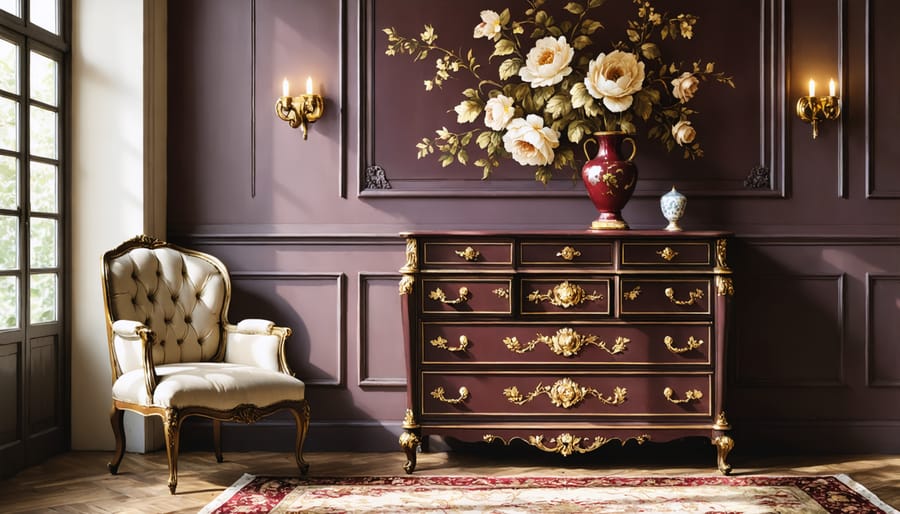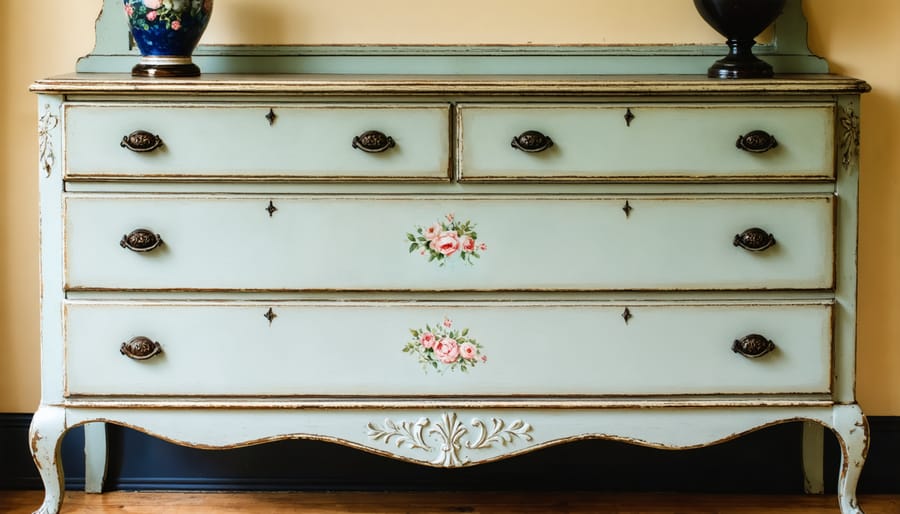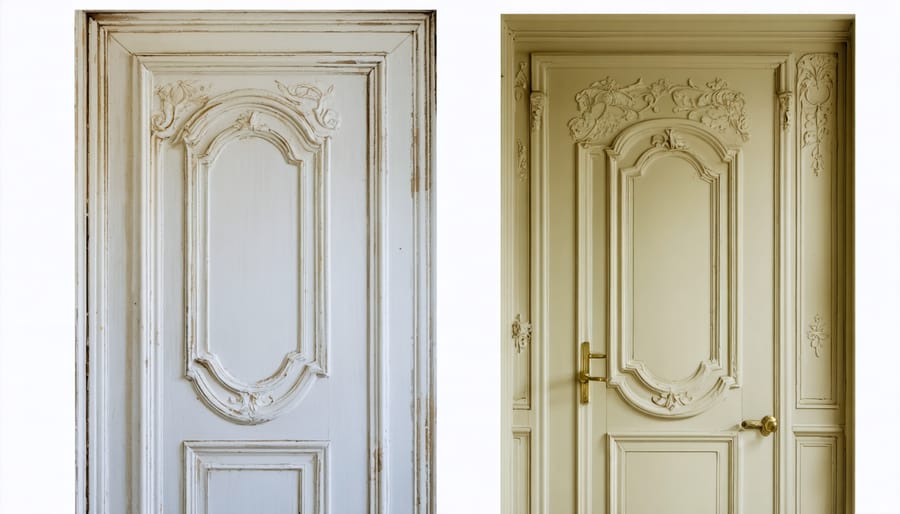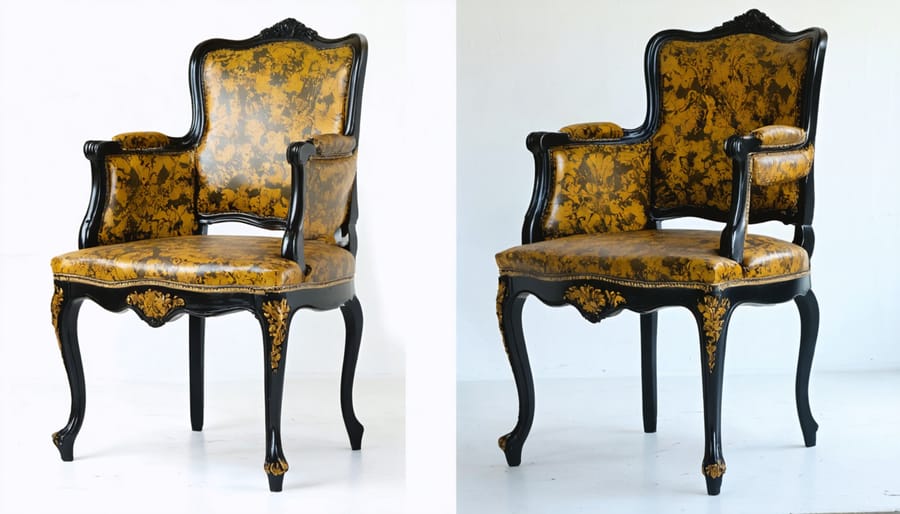
Discover the timeless elegance of Victorian furniture masterpieces transformed through the art of painted finishes. These ornate pieces, dating from 1837 to 1901, represent the pinnacle of furniture craftsmanship, with their intricate carvings, curved lines, and sophisticated detailing now reimagined in modern color palettes. While purists once insisted on maintaining original wood finishes, today’s designers and collectors increasingly embrace painted Victorian furniture as a way to preserve these historical treasures while adapting them to contemporary interiors. The marriage of authentic Victorian construction techniques with carefully chosen paint treatments creates stunning statement pieces that honor the past while embracing current design trends. Whether you’re considering refreshing an heirloom piece or seeking to authenticate a painted Victorian find, understanding the delicate balance between preservation and renovation ensures these magnificent pieces continue to tell their stories for generations to come.
Victorian furniture painters employed distinctive techniques that reflected the opulence of the era. The Industrial Revolution’s influence brought new paint formulations and tools, enabling craftsmen to achieve more intricate finishes than ever before.
Deep, rich colors dominated the Victorian palette, with dark greens, deep burgundies, and royal blues being particularly fashionable. Furniture pieces often featured hand-painted details, including delicate florals, gold leaf accents, and decorative borders. Multi-layering techniques were common, where painters would apply several coats to create depth and durability.
Popular finishing methods included faux graining, where skilled artisans would replicate expensive wood grains using specialized tools and glazes. Marble effects were also highly sought after, achieved through a complex process of base coating and feathering techniques.
Many pieces showcased the distinctive “sponging” method, which created subtle texture variations, while others displayed intricate stenciling patterns. These authentic Victorian techniques required considerable skill and patience, often taking several days to complete a single piece properly.

Victorian furniture pieces were carefully designed to serve both functional and decorative purposes in grand homes of the era. The parlor settee, often painted in soft pastels or cream tones, provided elegant seating for formal entertaining. Ladies’ writing desks, featuring delicate painted floral motifs, offered a dedicated space for correspondence and daily planning.
Painted Victorian dressers and armoires were statement pieces in bedrooms, combining ample storage with ornate decorative elements. These pieces typically featured hand-painted landscapes or botanical designs on their drawer fronts and panels. Side tables and occasional tables, adorned with detailed painted borders, served multiple functions throughout the home.
The iconic Victorian rocking chair, often painted in complementary colors to match other furniture, provided comfortable seating while showcasing the era’s distinctive curved lines. Corner whatnots – multi-tiered display shelves – offered space for decorative items and were frequently painted to coordinate with room color schemes.
Painted Victorian bedroom sets typically included matching nightstands, bed frames, and vanity tables, creating a cohesive look while maintaining functionality.
Identifying authentic Victorian paint requires a trained eye and knowledge of period-specific characteristics. Original painted surfaces often showcase distinctive crazing patterns – fine networks of tiny cracks that develop naturally over decades. These patterns are nearly impossible to replicate artificially and serve as one of the most reliable indicators of authenticity.
The color palette itself can reveal much about a piece’s originality. Victorian furniture makers favored certain shades that were popular during different periods within the era, particularly when creating revival furniture styles. Look for deep greens, rich burgundies, and warm earth tones, often with subtle variations in shade due to natural aging.
Another telltale sign is the presence of multiple paint layers when examining worn edges or chips. Original Victorian pieces typically show evidence of several paint applications over time, each layer telling part of the piece’s history. The paint’s texture should appear slightly uneven, with subtle brush strokes visible in some areas – a characteristic of hand-applied finishes common in the Victorian era.
The underside or back of furniture pieces can also provide valuable clues. These less-visible areas often retain original paint that’s better preserved than exposed surfaces, offering insight into the piece’s authentic appearance.

Painted Victorian furniture commonly exhibits distinct patterns of wear and damage due to its age and historical use. The most frequent issues include paint crazing, where fine networks of cracks appear across painted surfaces, particularly on pieces dating from the 1850s to 1890s. These characteristic patterns often develop due to temperature fluctuations and the natural aging of original paint formulations.
Areas of paint chipping and loss are typically concentrated around handles, edges, and high-contact zones like drawer fronts and chair arms. Many pieces show signs of water damage, especially on lower sections of legs and bases, resulting in paint bubbling and wood deterioration. The decorative details, such as hand-painted flowers or gold leaf accents, are particularly vulnerable to wear and often show significant fading or complete loss.
Victorian furniture frequently displays structural issues, including loose joints and separated veneer, particularly in pieces that have been exposed to varying humidity levels. The original castors may have damaged the bottom of legs, and upholstered elements commonly show deterioration of both fabric and underlying materials.
The distinctive milk paint or hand-mixed paint formulations used during the Victorian era can present unique restoration challenges, as these surfaces often react differently to modern finishing techniques. Understanding these common damage patterns is crucial for proper preservation and restoration, helping maintain both the piece’s historical integrity and value.
Before beginning any paint removal on Victorian furniture, it’s essential to determine if the existing finish is original or historically significant. If uncertain, consult a professional antique restorer for guidance. Once you’ve decided to proceed, start by testing the paint in an inconspicuous area to identify the most effective removal method.
For safe paint removal, begin with the gentlest approach possible. Use a quality chemical stripper specifically designed for furniture, applying it with natural-bristle brushes in a well-ventilated area. Work in small sections, allowing the stripper to penetrate the layers of paint before carefully scraping with plastic or wooden tools to avoid damaging the wood underneath.
Never use harsh mechanical methods like sanders on Victorian furniture, as these can destroy delicate details and reduce the piece’s value. Instead, rely on fine steel wool (0000 grade) and hand scraping for stubborn areas. For intricate carvings and decorative elements, utilize specialized stripping tools designed for detailed work.
After paint removal, neutralize any chemical residue according to the stripper manufacturer’s instructions. Allow the piece to dry thoroughly, then prepare the surface by hand-sanding with progressively finer grits, starting at 120 and working up to 220. Pay special attention to areas around carved details and joints, ensuring all surfaces are smooth but avoiding over-sanding, which can diminish the furniture’s character.
The final preparation step involves cleaning the bare wood with mineral spirits to remove any remaining dust or residue, creating an ideal surface for your new finish.
When selecting paint for Victorian furniture restoration, historical accuracy is paramount. During the Victorian era (1837-1901), the most commonly used colors were deep, rich hues including burgundy, forest green, and navy blue. These colors were often achieved using natural pigments mixed with linseed oil or milk-based paints.
For authentic restorations, consider using traditional paint formulations that mirror those of the period. Milk paint, made from milk protein (casein), lime, and natural pigments, was extensively used in Victorian times and remains an excellent choice today. It provides the characteristic matte finish and subtle color variations typical of period pieces.
Oil-based paints were also popular during this era, particularly for more formal furniture pieces. These created lustrous finishes that could be built up in layers for added depth and durability. Modern alternatives include specially formulated heritage paint lines that replicate Victorian color palettes while offering improved durability and environmental safety.
When choosing colors, consult period documentation or traces of original paint on your piece. Popular Victorian combinations included:
– Deep greens with gold accents
– Rich browns with black details
– Burgundy with dark wood trim
– Navy blue with gilt embellishments
For the most authentic results, avoid modern high-gloss finishes and instead opt for semi-gloss or eggshell sheens, which better reflect the technological limitations of Victorian-era paint manufacturing.

Achieving an authentic Victorian finish requires careful attention to detail and proper technique. Start by applying a quality primer specifically designed for furniture, allowing it to dry completely between coats. For the most authentic look, opt for oil-based paints in period-appropriate colors like deep greens, rich burgundies, or sophisticated blacks.
Layer your paint in thin, even coats using a high-quality natural bristle brush, working in the direction of the wood grain. Victorian pieces often featured multiple colors and decorative elements, so consider using different shades for moldings and carved details. Allow each layer to dry thoroughly before applying the next.
To achieve the signature Victorian aged appearance, consider implementing subtle distressing techniques on edges and high-wear areas. This can be done carefully with fine-grit sandpaper or steel wool. For ornate pieces, highlight detailed carvings by applying a slightly darker glaze, wiping away excess to create depth and dimension.
The final touch involves protecting your work with a period-appropriate finish. While modern polyurethane is durable, traditional shellac or wax finishes provide a more authentic appearance. Apply multiple thin coats of your chosen finish, lightly sanding between layers for a smooth result. The final coat should be buffed to achieve that characteristic Victorian luster without appearing too glossy or modern.
Regular maintenance of painted Victorian furniture ensures its beauty and longevity. Start by dusting your pieces weekly using a soft, clean microfiber cloth to prevent particle buildup that can scratch the painted surface. Avoid feather dusters, which can catch on decorative elements and damage the finish.
For deeper cleaning, use a solution of mild soap and lukewarm water. Never saturate the surface; instead, slightly dampen a soft cloth and gently wipe the painted areas. Immediately dry with a clean, lint-free cloth to prevent water damage. Avoid commercial furniture polishes, as these can create a sticky residue that attracts dust and may interact poorly with historic paint finishes.
Keep painted Victorian furniture away from direct sunlight and heat sources to prevent fading and paint deterioration. Maintain consistent room humidity levels between 40-50% to prevent wood expansion and contraction that could crack the paint. Use felt pads under decorative items placed on painted surfaces to prevent scratching.
Address any chips or flaking paint promptly to prevent further damage. Consider professional restoration for significant paint issues rather than attempting DIY repairs that might compromise the piece’s value.
To maintain the beauty and integrity of your painted Victorian furniture, we recommend following a professional maintenance schedule. Schedule a detailed inspection by a qualified restoration expert every 12-18 months, depending on the piece’s age and condition. These inspections should assess paint adhesion, check for developing cracks, and evaluate the stability of joints and decorative elements.
Professional touch-ups should be performed every 2-3 years to address any paint wear, particularly on high-touch areas like arms, edges, and decorative trim. For pieces displayed in direct sunlight or high-traffic areas, consider scheduling touch-ups annually to prevent UV damage and excessive wear.
A complete professional cleaning should be done every 6 months using specialized products and techniques that won’t damage the delicate painted surfaces. If your furniture shows signs of paint lifting, bubbling, or crackling, don’t wait for scheduled maintenance – seek professional attention immediately.
For antique pieces over 100 years old, increase inspection frequency to every 6-9 months, and consider a full restoration assessment every 5 years to preserve both value and appearance.
Properly restored painted Victorian furniture holds a special place in today’s homes, bridging the gap between historical elegance and contemporary living spaces. As modern interior design trends continue to embrace character-rich pieces, these restored treasures serve as stunning focal points that tell stories of craftsmanship and artistic expression from a bygone era.
The value of professionally restored painted Victorian furniture extends beyond mere aesthetics. These pieces represent sustainable luxury, offering an environmentally conscious alternative to mass-produced furniture while providing superior quality and durability. When properly maintained, they become lasting investments that appreciate over time, both financially and sentimentally.
In contemporary homes, painted Victorian furniture adds layers of sophistication and personality that simply cannot be replicated by modern reproductions. Whether it’s a beautifully restored dresser in a master bedroom or an ornate side table in a minimalist living room, these pieces create striking contrasts that elevate any interior design scheme.
The preservation of these historical pieces through professional restoration ensures that future generations can continue to enjoy their beauty and craftsmanship. By investing in quality restoration work, homeowners not only enhance their living spaces but also become custodians of architectural history, maintaining the artistry and elegance of the Victorian era for years to come.